This site is supported by our readers. We may earn a commission, at no cost to you, if you purchase through links.
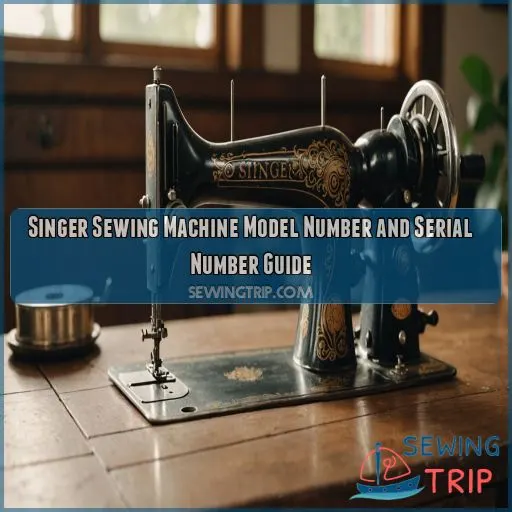 To identify your Singer sewing machine model, you need to locate the model number. This is usually printed on a plate at the back, side, or even the front of the machine. Each model number corresponds to specific features and a production period. For example, the Singer 15K was manufactured from 1910 to 1964, while the Singer 201K was produced from 1935 to 1962. The model number will help you pinpoint the exact details of your machine, including its age and unique characteristics.
To identify your Singer sewing machine model, you need to locate the model number. This is usually printed on a plate at the back, side, or even the front of the machine. Each model number corresponds to specific features and a production period. For example, the Singer 15K was manufactured from 1910 to 1964, while the Singer 201K was produced from 1935 to 1962. The model number will help you pinpoint the exact details of your machine, including its age and unique characteristics.
If you’re having trouble finding the model number, stay tuned as we’ll also cover how to identify your Singer sewing machine using its serial number.
Table Of Contents
- Key Takeaways
- Identifying Your Singer Sewing Machine
- Singer Sewing Machine Models Explained
- Decoding Singer Serial Number Patterns
- The Importance of Serial Number Research
- Singer Sewing Machine History and Evolution
- Singer Sewing Machine Age Guide
- Singer Sewing Machine Model Identification and Value
- Frequently Asked Questions (FAQs)
- Conclusion
Key Takeaways
- Singer sewing machines have a rich history, and their serial and model numbers are like secret codes that unlock this past.
- These codes reveal the manufacturing date, model, and unique characteristics of your machine, helping you understand its place in the evolution of sewing technology.
- By deciphering these codes, you can determine the value of your machine, especially if it’s a vintage or antique model.
- Knowing your Singer’s serial and model numbers can also be a lifesaver when it comes to repairs, restoration, and sourcing spare parts.
Identifying Your Singer Sewing Machine
Whether you’re a sewing enthusiast or a collector, knowing what kind of Singer sewing machine you have is important. Each Singer machine has a unique story to tell, and you can learn about its history by deciphering its model number and serial number.
In this section, we’ll guide you through the process of identifying your Singer sewing machine like a pro. We’ll show you where to find the serial number, how to make sense of its pattern, and how to use online databases to uncover your machine’s history.
Finding the Serial Number
So, you’ve got your hands on a Singer sewing machine, and you’re curious about its history, right? Well, the first step is to locate its serial number. This unique code is like a secret password, revealing your machine’s past.
You’ll usually spot the serial number hanging out on the machine’s base or chilling underneath the bed. It’s a mix of letters and numbers, with the letters giving a sly wink to the year it was made, and the numbers dishing out specific details about its place in that year’s production line.
With this info, you’re well on your way to becoming a Singer sleuth!
Understanding the Serial Number Pattern
Now that you’ve located your serial number, let’s decipher its meaning. Singer sewing machine serial numbers typically follow a specific pattern that includes both letters and numbers. Here’s a breakdown of the key components:
- Letter Prefixes: The letter at the beginning of the serial number, like "AA," "AB," or "AC," indicates the model series and manufacturing year.
- Number Sequences: The numerical sequence that follows the letter prefix reveals the specific machine’s production order within that year.
- Model Variations: Different variations of the same model may exhibit slight differences in serial number patterns, so it’s important to cross-reference with other details like physical characteristics.
Using Online Databases for Research
N/A
Singer Sewing Machine Models Explained
Singer sewing machines come in a variety of models, each with its own unique features and capabilities. In this section, we’ll be taking a closer look at the different Singer sewing machine models, including the AA, AB, AC, AD, and AE series, so you can better understand the specifications of your machine and how it fits into the Singer lineup.
AA Series Machines
The AA Series covers a range of Singer sewing machine models.
The serial number is key to figuring out when yours was made.
It’s like a secret code that tells you your machine’s history.
Each Singer sewing machine has its own unique serial number.
These little numbers are like a time capsule, taking you back to the year your machine was born.
AB Series Machines
The AB Series machines are a continuation of the AA series, with the serial number acting as a key to figuring out the year of manufacture. Knowing the manufacturing date is a superpower when it comes to understanding the history and value of your machine. The AB series, like its predecessor, plays a part in the evolution of Singer’s sewing machines, a journey marked by innovation, accessibility, and a range of features that cater to sewers of all levels.
Here are three key facts about the AB Series:
- The AB series includes a range of Singer models, each with its own unique features and capabilities.
- The serial number is a vital identifier, helping you discover when your machine was made and its place in Singer’s history.
- Understanding the AB series is a step in the right direction to mastering Singer’s extensive sewing machine range and its impact on the sewing world.
AC Series Machines
The AC series of Singer sewing machines follows the same pattern as the previous series, with the serial number helping you pinpoint the manufacturing date.
You can use this serial number to look up the production dates and model variations of your machine.
This is especially helpful if you’re curious about the history of your machine or need to find parts for repair.
AD Series Machines
If you’re curious about the AD series, these serial numbers can be used to identify the year your Singer machine was made.
AE Series Machines
The AE Series is another set of Singer sewing machines with serial numbers that can be used to determine their manufacturing year. By looking up the serial number of your AE Series machine, you can uncover its production date and historical context. This information is invaluable for collectors and enthusiasts who want to understand the evolution of Singer sewing machines.
Decoding Singer Serial Number Patterns
Whether you’re a sewing enthusiast or a collector, decoding Singer serial numbers can feel like cracking a code. But don’t worry, we’re here to help you make sense of it all.
Letter Prefixes and Manufacturing Years
Now that you’ve familiarized yourself with the different Singer sewing machine models, let’s get into the world of letter prefixes. These prefixes, like "AA," "AB," and "AC," are more than just random letters; they’re like a secret code that tells you when your machine was made. It’s like having a time-traveling machine that whispers, "This one’s from way back when.
Number Sequences and Manufacturing Dates
The numerical sequence within your Singer sewing machine’s serial number can reveal its manufacturing date. For instance, a serial number like "AA123456" has the number sequence "123456." This sequence, in conjunction with the letter prefix "AA," helps pinpoint the manufacturing date.
- Imagine a serial number like a code, with each part offering a clue to your machine’s history.
- The numerical sequence, like a secret password, figures out its manufacturing date.
- Each number in the sequence contributes to the overall puzzle, providing a specific piece of information.
- These numbers, when decoded, can tell you the year your machine was made, like a time stamp in history.
- Think of it as a unique identifier, setting your machine apart from others and giving you insight into its past.
Model Variations and Historical Context
Now, let’s talk about model variations and their historical context.
Different model variations within a series may have slightly different serial number patterns.
So, it’s like each variation has its own unique twist on the serial number puzzle.
To truly understand these patterns, it’s important to know the history of Singer sewing machines.
Imagine you’re a detective, unraveling the story behind these machines and their serial numbers—it’s like solving a historical mystery!
The Importance of Serial Number Research
Whether you’re a collector, a repair enthusiast, or simply curious about your vintage Singer sewing machine, serial number research is key. Knowing how to interpret these unique codes can reveal your machine’s manufacturing date, model, and historical significance.
Historical Significance of Singer Machines
Singer sewing machines have a rich history that extends beyond their practical use. These machines are icons of a bygone era, beloved by collectors and enthusiasts alike. Here’s why serial number research is essential:
- Historical Significance: Singer sewing machines have a long and fascinating history, with the company being the first to introduce electric, zigzag, and electronic sewing machines to the home market.
- Craftsmanship and Legacy: By researching serial numbers, you can uncover the story behind each machine, including its manufacturing date, model, and unique features. This knowledge helps appreciate the craftsmanship and attention to detail that went into creating these machines.
- Uncovering Antique Treasures: Many Singer sewing machines are antique treasures, passed down through generations. Understanding their age and model through serial numbers adds to their charm and sentimental value.
- A Glimpse into Sewing History: Each Singer sewing machine is a time capsule, reflecting the fashion, culture, and technology of its era. Serial number research connects you to a community of enthusiasts who appreciate the evolution of sewing machines.
- Community and Resources: Online communities and databases dedicated to Singer sewing machines provide a wealth of information. Engaging with these resources helps build a network of like-minded individuals passionate about sewing history and preservation.
Determining the Value of Your Machine
Want to know how much your Singer sewing machine is worth?
Serial number research can help you figure it out.
The manufacturing date and model you find using the serial number are key to figuring out your machine’s value.
Rare, vintage models in good condition can be worth a lot, especially if they have unique features or are popular with collectors.
Repair and Restoration Using Serial Numbers
Figuring out your vintage Singer sewing machine’s serial number is like having a secret weapon when it comes to fixing it up. Here’s why:
- Parts Sourcing: Knowing your machine’s serial number is like having a secret code that opens up a treasure chest of spare parts. You can easily find and order the exact pieces you need for repairs or upgrades.
- Restoration Guidance: With the serial number, you get access to tons of information on how to restore your machine, with tips specific to your machine’s model and year. It’s like having a personal restoration manual!
- Vintage Value: Understanding the age and model of your machine through its serial number can help you figure out how much it’s worth. This is especially important if you’re thinking about selling or getting insurance for your vintage Singer.
- Sewing Machine Repair: Whether you’re tackling a repair yourself or going to a professional, having the serial number handy is like having a direct line to the experts. It means you get accurate advice and help that’s perfect for your machine.
Collector’s Perspective on Serial Numbers
For collectors, serial numbers are like a treasure map leading to the history and rarity of their machines. They provide a unique perspective on the craftsmanship and legacy of Singer sewing machines. Imagine being able to trace the journey of your machine, understanding its place in the evolution of sewing technology. It’s like holding a piece of history in your hands.
The serial number reveals the manufacturing date, model, and even specific variations, all of which contribute to the story of your machine. It’s like having a secret code that reveals the mysteries of its past and present value.
Singer Sewing Machine History and Evolution
Singer sewing machines have a long history of innovation, affordability, and accessibility. From introducing the first electric and zigzag machines to the home sewing market to their current range of machines for all levels, Singer has focused on making sewing accessible to everyone.
Innovation in the Sewing Machine Industry
Singer has left an indelible mark on the sewing machine industry, pioneering innovations that transformed the way we sew. They were the first to introduce:
- Electric sewing machines, bringing power and efficiency to the home sewing market.
- Zigzag sewing machines, adding a creative twist to stitching.
- Electronic sewing machines, merging technology and tailoring.
Singer’s commitment to innovation has continued through the years, with modern machines boasting features like automatic needle threaders and LCD screens. Their focus on accessibility and affordability has made them a go-to brand for sewers of all levels, from beginners to professionals.
Singer’s Focus on Affordability and Accessibility
Singer’s focus on affordability and accessibility has been a key part of the brand’s history and legacy. Singer sewing machines have been designed with the everyday user in mind, offering a range of features to suit different needs and budgets.
| Singer’s Focus | Impact |
|---|---|
| Affordability | Singer machines are priced between £149 and £1299, catering to a wide range of budgets. |
| Accessibility | Singer offers a variety of machines for all skill levels, from beginners to professionals. |
| Innovation | Singer was the first to introduce electric, zigzag, and electronic sewing machines to the home sewing market, making advanced features accessible to all. |
| Reliability | Singer machines are known for their durability and reliability, ensuring a worthwhile investment. |
| Support | Singer provides a range of resources, including manuals, classes, and troubleshooting tips, to support users in their sewing journey. |
Features and Capabilities of Modern Singer Machines
Modern Singer sewing machines are packed with innovative features that streamline your sewing projects, from automatic needle threaders that save you time and frustration to LCD screens that provide clear visuals and intuitive control. Here’s a list of some key features:
- Automatic needle threaders
- LCD screens
- A wide range of machines catering to all levels of experience
- Reliable and durable construction
Whether you’re a beginner or a seasoned pro, Singer has a machine that’s perfect for you, offering both affordability and accessibility without compromising on quality.
Singer Sewing Machine Age Guide
Singer Sewing Machine Age Guide:
Have you ever wondered how old your trusty Singer sewing machine is? Well, wonder no more! This guide will help you determine the age of your machine using its serial number.
Serial Number Breakdown by Year
To figure out the manufacturing year of your Singer sewing machine, you need to look at the serial number.
The serial number is usually found on the machine’s base or underneath the bed.
The letters in the serial number indicate the year of manufacture.
The numbers in the serial number pinpoint the specific machine within that production year.
For example, if your serial number starts with "AB," you can narrow down the manufacturing year to a specific range.
This dating system is like a fun treasure hunt, giving you a glimpse into the history of your trusty sewing companion.
Model Identification Using Serial Numbers
Your Singer sewing machine’s model can be identified using its serial number. This unique code, found on the machine’s base or underneath the bed, consists of letters and numbers. The letters indicate the manufacturing year, while the numbers pinpoint the specific machine within that year.
Determining the Age of Your Singer Machine
So, you want to figure out the age of your Singer sewing machine? Well, you’re in luck! Each Singer sewing machine has a unique serial number that holds the key to its manufacturing date. These serial numbers are like a secret code, waiting to be cracked. With a bit of detective work, you can unravel the mystery and travel back in time to the year your machine was born.
Let’s get started on this time-travelling journey!
Singer Sewing Machine Model Identification and Value
Now that you know how to uncover the manufacturing date of your Singer sewing machine, it’s time to get a handle on model identification and value assessment. In this section, we’ll explore how to locate the model number and figure out what it means.
Understanding your machine’s model number is important for a few reasons, from finding compatible parts to figuring out its market value.
Finding the Model Number
Now that you know how to determine the age of your Singer sewing machine, let’s move on to finding the model number.
This is really important for identifying your machine’s features, capabilities, and value.
The model number is often found on the machine’s base or on a label.
It’s like your machine’s unique fingerprint, setting it apart from other Singer models.
Determining the Value of Your Singer Machine
Knowing the manufacturing date and model of your Singer sewing machine is key to figuring out its value. If you’re curious about the worth of your machine, it’s time to get your detective hat on and start researching.
Vintage value, repair costs, and market trends all play a role in determining a machine’s worth. For instance, older models might be more valuable to collectors, but they may also require costly repairs. On the other hand, newer machines might’ve more advanced features but could depreciate faster.
Condition is another important factor. A well-maintained machine in good working order will likely be more valuable than one that’s seen better days.
Comparing Features and Capabilities of Singer Machines
Choosing the right Singer sewing machine is like picking your favorite ice cream flavor—they all have their own features and what they’re good at, depending on what you need. Here’s a way to think about the differences:
- Stitch Options: Some machines have a ton of stitch options, from basic straight and zigzag stitches to fancy ones like buttonholes and embroidery. If you’re a creative type, look for a machine with more stitch variety.
- Speed and Efficiency: If you like to sew fast, consider machines that stitch quickly and have automatic features like needle threaders and thread cutters. These will save you time and make sewing easier.
- Durability and Warranty: Singer machines are known for being tough, but some models offer extra-long warranties for peace of mind. If you’re going to use your machine a lot, consider getting one with a longer warranty.
Frequently Asked Questions (FAQs)
How can I tell what model Singer sewing machine I have?
Finding your Singer sewing machine’s model is a breeze. Check the machine’s base or a label for the model number. If it’s an older machine without a model number, the serial number can help.
What is my Singer sewing machine worth?
The value of your Singer sewing machine depends on its model, collectability, and condition. Most sell for $50 to $500, but rare models like the 222K can fetch over $2,
What is the most sought after Singer sewing machine?
The Singer 66 is a highly sought-after model, especially the treadle version with its ‘red eye’ decals. Early Singer models mounted on stands with a single pedal are also popular.
Are old sewing machines worth money?
Antique sewing machines can be worth hundreds or even thousands of dollars. Age and condition are key factors in determining value. Sewing machines from the mid to late 1800s are especially valuable due to their historical importance.
Where can I find the model number?
If your machine is newer, the model number will be on the handwheel, near the electric cord. If it’s older, look on the front panel, or above or below the stitch controller. For machines pre-1960, check the small plate on the front.
How much is my Singer sewing machine worth?
The value of your Singer sewing machine depends on its model, condition, and rarity. While most sell for $50-$150, some are worth thousands, especially rare, early models in good condition.
What do I do if my serial number is worn away?
If your serial number is worn away, you could try re-engraving it yourself, but this may not look great. If you want it to look nice, consider getting it laser engraved at a gun store. Or, you could contact the manufacturer to see if they can help.
What do I need to know about Singer sewing machine maintenance?
Maintaining your Singer sewing machine is essential for its longevity. Regularly check the bobbin and case for dust, keep the machine lubricated, and monitor the tension and electricals. Timing adjustments are also key.
Are Singer sewing machines still made today?
Singer sewing machines are still made today, but they’re no longer produced in the USA. Instead, they’re manufactured in China, Vietnam, or Japan. Singer’s most popular models are available on the market.
Conclusion
So, there you have it—a complete guide to Singer sewing machine model and serial number identification.
You’re now equipped with the know-how to figure out the history of your Singer sewing machine.
Whether you’re a collector, a hobbyist, or simply curious about your machine’s backstory, the model and serial numbers are your keys to understanding its unique history and place in the evolution of sewing technology.

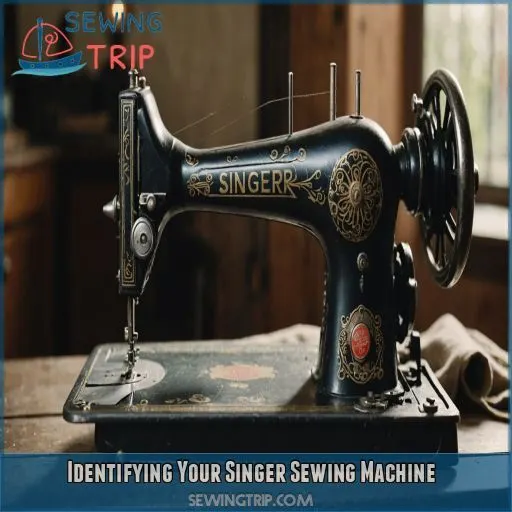
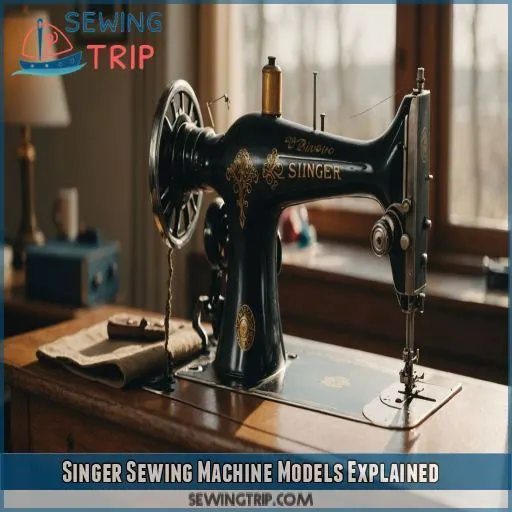
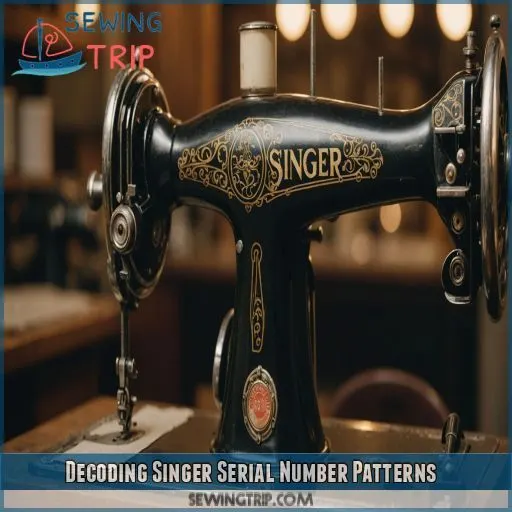
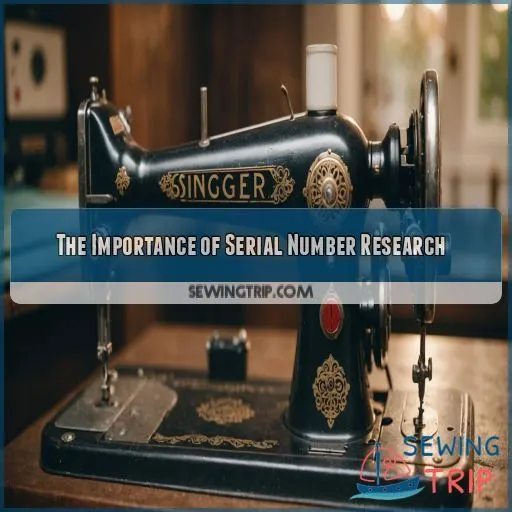
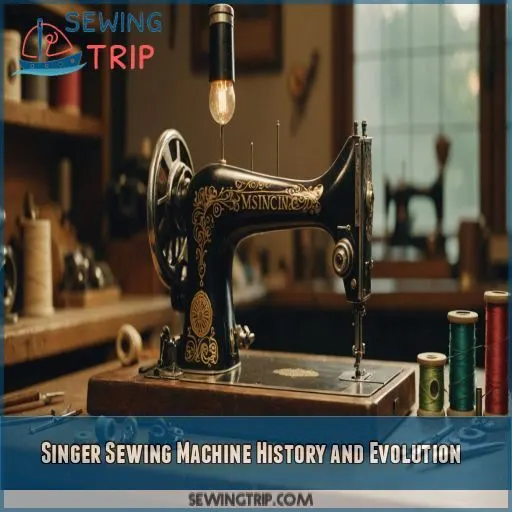
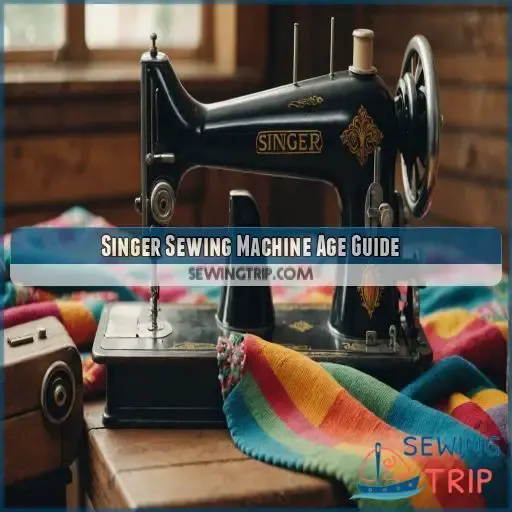
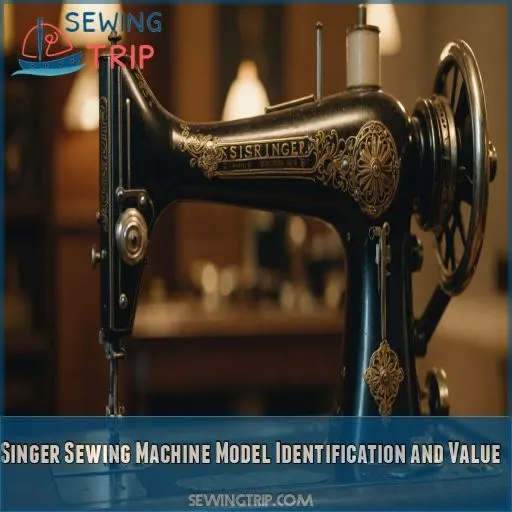






Ann
November 19, 2025 at 11:54 PM
I have a singer that was given to me ,and i know nothing about it . Model # F5618451 and i can't seem to find it on your site .
Cheryl Morris
October 7, 2025 at 09:17 PM
I just found a Singer at a yard sale , the serial number is C82298379. How can I determine how old it is .?
Marcia Stanbrough
August 26, 2025 at 12:59 PM
I have an AE351967 Singer sewing machine. This AE number is on the front. I has a gold colored badge on the lower right side on the front.. It is electric, with a drop down knee peddle. I don't know how old it is, I have had it a long time. I haven't used it for a long time as my eye sight is now keeping me from doing much sewing. It is in a nice wooden cabnet, the machine drops down into the cabnet & the sides are hinged to fold up over to enclose the machine. There is a small drop out drawer across the front. Since I haven't used it for a long time, I am sure it needs a good cleaning & oiling. But the mecanics of it all run smoothly. I would like to sell it, is a shame to just let it sit. Could you give me an idea what it is worth?
James Terrell
July 3, 2025 at 07:40 PM
I have a Singer Serial #C7264686, I cant find any info on this machine. CAn you help?
Mutasim Sweileh
August 15, 2025 at 06:04 PM
Hello, your “C7264686” is almost certainly a Singer made at the Wittenberge (Germany/Prussia) factory. Those machines use a C-prefix serial and (usually) have the model stamped with a “D” suffix (e.g., 15D, 66D, 201D, 206D). Exact dating by serial isn’t possible because Singer’s Wittenberge serial records didn’t survive, so most “C-series year charts” online are guesswork.
Here’s how to positively ID yours (no serial database needed):
1. Look for the model badge on the front/bed: if it says something like 15D / 66D / 201D / 206D, that’s the model. 2. Check the bobbin system: - Side-loading, round bobbin in an oscillating hook → likely Class 15D. - Top-drop-in bobbin (under a slide plate) → likely 66D. - Gear-driven “potted” motor on the back, straight stitch → 201D. - Factory zigzag with special 206x13 needle system → 206D. (Model families documented; the “D” just marks Wittenberge.) Fiddlebase 3. Location/format sanity check from Singer: older machines may have one letter + up to 7 digits on the bed or a plate; newer electrics often have two letters + 6 digits underneath. Yours fits the older pattern.
Karen Donnelly
June 22, 2025 at 10:54 PM
I can't find anything about my grandma's Singer sewing machine. I know it's quite old. It was originally a treadle, which my grandad electrified. The number is 3867678. There were no letters. Thanks
Mutasim Sweileh
August 15, 2025 at 06:26 PM
Here's what we know about similar cases:
Serial numbers are found on the machine's base or under the bed. They typically include a letter prefix to denote the manufacturing location and year, but your serial number does not have a prefix, which might indicate it's a pre-1900 machine.
Based on early serial number patterns, machines in this range (around 3.8 million) could have been produced in the late 1800s or early 1900s. However, without physical inspection or comparison using detailed factory documentation, pinpointing the exact model is challenging.
For further clarification:
Investigate physical details like the bobbin system, decals, and construction features. Use resources like the International Sewing Machine Collectors' Society (ISMACS) database to match models based on these features. Reach out to Singer archives or sewing machine restoration experts for direct assistance.